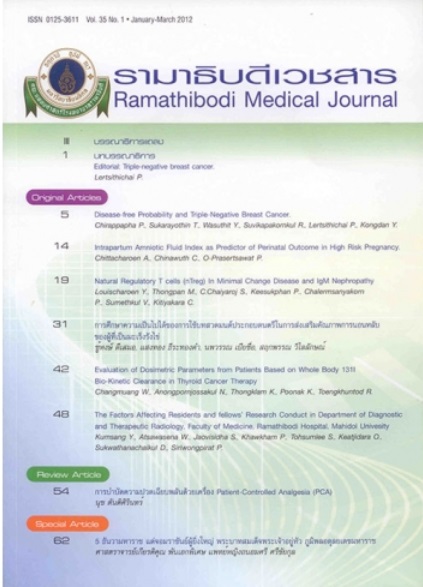Disease-free Probability and Triple-Negative Breast Cancer
Main Article Content
Abstract
Objective: To compare the probabilities of local recurrence and distant metastasis between women with triple-negative and non- triple negative breast cancers.
Methods: Medical and pathological records of breast cancer patients treated between the years 2002 and 2006 were reviewed.
Results: There were 256 patients with complete data on estrogen receptor (ER), progesterone receptor (PR), and human epidermal growth factor receptor-2 (HER2) expression determinations. There were 54 patients (21%) with triple-negative (ER-, PR-, HER2 -) cancers. Triple-negative patients were more likely to have larger tumors with higher histologic grade. The median fallow-up time was 4 years. The probabilities of local and distant recurrence were similar between the two groups of patients. Only two factors were independently and significantly associated with overall recurrence: tumor stage and tumor size.
Conclusion: Triple-negative breast cancer did not have a higher risk for both local recurrence and distant metastasis when compared with non-triple negative cancer.
Article Details
References
Reis-Filho JS, Tutt AN. Triple negative tumours: a critical review. Histopathology. 2008;52(1):108-18. doi:10.1111/j.1365-2559.2007.02889.x.
Cleator S, Heller W, Coombes RC. Triple-negative breast cancer: therapeutic options. Lancet Oncol. 2007;8(3):235-44. doi:10.1016/S1470-2045(07)70074-8.
Ray M, Polite BN. Triple-negative breast cancers: a view from 10,000 feet. Cancer J. 2010;16(1):17-22. doi:10.1097/PPO.0b013e3181d3eef5.
Irvin WJ Jr, Carey LA. What is triple-negative breast cancer? Eur J Cancer. 2008;44(18):2799-805. doi:10.1016/j.ejca.2008.09.034.
Nishimura R, Arima N. Is triple negative a prognostic factor in breast cancer? Breast Cancer. 2008;15(4):303-8. doi:10.1007/s12282-008-0042-3.
Kaplan HG, Malmgren JA, Atwood M. T1N0 triple negative breast cancer: risk of recurrence and adjuvant chemotherapy. Breast J. 2009;15(5):454-60. doi:10.1111/j.1524-4741.2009.00789.x.
Kaplan HG, Malmgren JA. Impact of triple negative phenotype on breast cancer prognosis. Breast J. 2008;14(5):456-63. doi:10.1111/j.1524-4741.2008.00622.x.
Jumppanen M, Gruvberger-Saal S, Kauraniemi P, Tanner M, Bendahl PO, Lundin M, et al. Basal-like phenotype is not associated with patient survival in estrogen-receptor-negative breast cancers. Breast Cancer Res. 2007;9(1):R16. doi:10.1186/bcr1649.
Gonzalez-Angulo AM, Litton JK, Broglio KR, Meric-Bernstam F, Rakkhit R, Cardoso F, et al. High risk of recurrence for patients with breast cancer who have human epidermal growth factor receptor 2-positive, node-negative tumors 1 cm or smaller. J Clin Oncol. 2009;27(34):5700-6. doi:10.1200/JCO.2009.23.2025.
Yin WJ, Lu JS, Di GH, Lin YP, Zhou LH, Liu GY, et al. Clinicopathological features of the triple-negative tumors in Chinese breast cancer patients. Breast Cancer Res Treat. 2009;115(2):325-33. doi:10.1007/s10549-008-0096-0.
Edge SB, Byrd DR, Compton CC, Fritz AG, Greene FL, Trotti A, editors. AJCC Cancer Staging Handbook: From the AJCC Cancer Staging Manual. 7th ed. New York, NY: Springer; 2010:347-76.
Carey LA, Perou CM, Livasy CA, Dressler LG, Cowan D, Conway K, Race, breast cancer subtypes, and survival in the Carolina Breast Cancer Study. JAMA. 2006;295(21):2492-502. doi:10.1001/jama.295.21.2492.
Kurebayashi J, Moriya T, Ishida T, Hirakawa H, Kurosumi M, Akiyama F, et al. The prevalence of intrinsic subtypes and prognosis in breast cancer patients of different races. Breast. 2007;16 Suppl 2:S72-7. doi:10.1016/j.breast.2007.07.017.
Fulford LG, Reis-Filho JS, Ryder K, Jones C, Gillett CE, Hanby A, et al. Basal-like grade III invasive ductal carcinoma of the breast: patterns of metastasis and long-term survival. Breast Cancer Res. 2007;9(1):R4. doi:10.1186/bcr1636.
Liu H, Fan Q, Zhang Z, Li X, Yu H, Meng F. Basal-HER2 phenotype shows poorer survival than basal-like phenotype in hormone receptor-negative invasive breast cancers. Hum Pathol. 2008;39(2):167-74. doi:10.1016/j.humpath.2007.06.012.
Fernandes RC, Bevilacqua JL, Soares IC, Siqueira SA, Pires L, Hegg R, et al. Coordinated expression of ER, PR and HER2 define different prognostic subtypes among poorly differentiated breast carcinomas. Histopathology. 2009;55(3):346-52. doi:10.1111/j.1365-2559.2009.03380.x.
Gong Y, Yan K, Lin F, Anderson K, Sotiriou C, Andre F, et al. Determination of oestrogen-receptor status and ERBB2 status of breast carcinoma: a gene-expression profiling study. Lancet Oncol. 2007;8(3):203-11. doi:10.1016/S1470-2045(07)70042-6.




